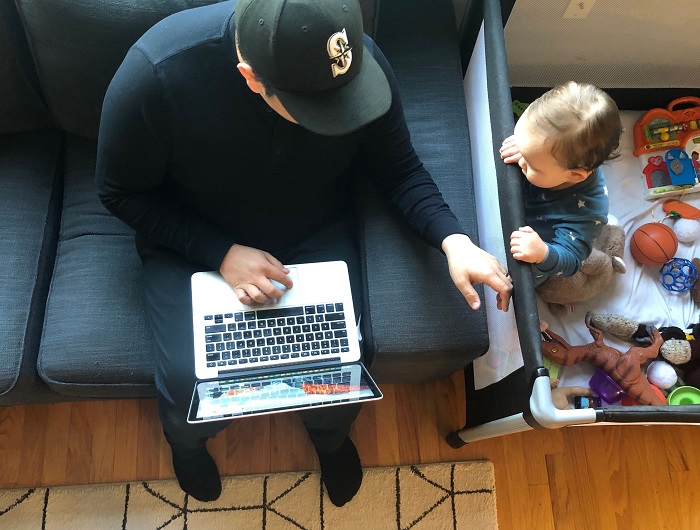 Parents are facing some high expectations right now. The COVID-19 pandemic has brought a wave of uncertainty to our homes, impacting finances, food security, health and safety. And while that would have been plenty to worry about, many parents are also required to work from home while managing their child’s education at the kitchen table.
Parents are facing some high expectations right now. The COVID-19 pandemic has brought a wave of uncertainty to our homes, impacting finances, food security, health and safety. And while that would have been plenty to worry about, many parents are also required to work from home while managing their child’s education at the kitchen table.
It’s a lot.
“We know there are direct correlations between parental stress and a parent’s ability to give their child the one-on-one positive interaction that kids need to thrive,” said Dr. Megan Frye, a child psychologist at Seattle Children’s Odessa Brown Children’s Clinic. “We also know that the brain is super flexible. When we are going through stressful experiences, we as parents can learn and implement concrete skills and practices that will help us manage our own stress, connect better with our children and model what it looks like to be resilient when things are challenging.”
Reducing anxiety can feel impossible if your child care is obsolete and you don’t have time for an hour-long yoga class. On the Pulse has collaborated with Seattle Children’s experts to identify practical tips to help parents manage their stress during the COVID-19 pandemic and long after.
Managing anxiety and fear
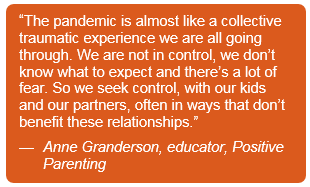 Dr. Kendra Read, clinical psychologist and director of anxiety programs with Seattle Children’s Psychiatry and Behavioral Medicine team
Dr. Kendra Read, clinical psychologist and director of anxiety programs with Seattle Children’s Psychiatry and Behavioral Medicine team
It’s important to recognize anxiety is a totally normal and adaptive emotion that helps us prepare for potential threats. Arguably, COVID-19 fits the bill. So, experiencing anxiety during this time is not an indicator that you’re doing something wrong.
The first thing I recommend to parents (or anyone with anxiety) is validate your emotional experience, and your child’s. Giving voice to your feelings can be helpful in itself.
We should also recognize that this is an uncertain time and learning to cope with uncertainty is a lifelong skill. This is an opportunity for us to learn how to sit in moments of uncertainty.
One effective way to manage anxiety is to become critical and selective consumers of information, and that includes your own thoughts. Anxiety makes us overestimate the risks of a situation and underestimate our ability to cope with it.
Try to stick to information from the U.S. Centers for Disease Control and Prevention (CDC) and local health agencies. By filtering the abundance of available information about COVID-19, we can find reputable facts and use those to critically evaluate and challenge our fears.
Our thoughts impact our behaviors. When we feel anxious, we may start avoiding things or start overdoing things. For example, we might start over-examining our body sensations, excessively washing our hands or stockpiling resources beyond what health guidelines recommend. Take a moment to ask, what evidence can I use to evaluate my thoughts in a healthy way?
Have a plan to calm down
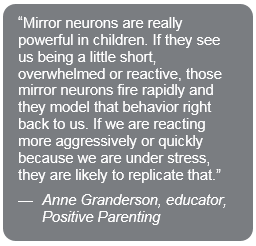 Anne Granderson, Positive Parenting educator
Anne Granderson, Positive Parenting educator
The circumstances of the COVID-19 pandemic are dramatically impacting our lives and may be causing big emotions like fear and frustration.
When we’re feeling these big emotions, the thinking part of our brain goes offline and we become reactive instead of responsive. In order to learn and rationalize, we have to first be calm.
It can be helpful to have a plan for calming down before you need it. Here are a few ideas that can be done with or without your child:
- Take five breathing: Physically connect with your child by putting your palms together (or simply hold up your own hand) and count five deep breaths together.
- Mantras: Have a phrase to ground you when your emotions run high, such as “This is not an emergency.”
- Engage your thinking brain: Read a book out loud, turn on music, count, do a puzzle or another thinking activity to engage the part of your brain that is rational.
- Change of scenery: Step outside, try a “do over,” hide under a blanket or light a candle.
Inevitably, we’re going to lose it sometimes. When we do, here are some tips on how to respond:
- Acknowledge: Let kids know we aren’t perfect and that they don’t have to be either. Mistakes are opportunities to learn.
- Make it right: Apologize. Model what it looks like to attempt a repair.
- Forgive: Model self-compassion and avoid guilt for your actions.
What we know now about child development and brain function is that kids’ perception of the world is heightened. They are like barometers, paying close attention to facial cues and body language.
Even if we are not talking about being stressed, our kids sense it. Unless we talk about it, they are making their own sense of it — either thinking that it’s their fault and or jumping to scary conclusions about the world around them.
Make time for realistic self-care practices
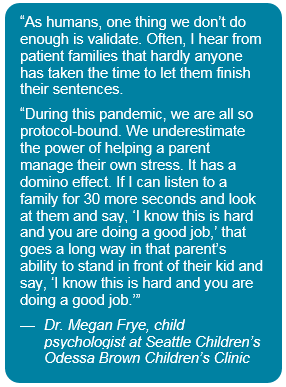 Dr. Megan Frye, child psychologist at Seattle Children’s Odessa Brown Children’s Clinic
Dr. Megan Frye, child psychologist at Seattle Children’s Odessa Brown Children’s Clinic
We are starting to find out this situation is a marathon; it’s not a sprint. To be sustainable in this environment, where we have all had to be super flexible, we need to check in with ourselves emotionally, spiritually and physically every day.
This doesn’t necessarily mean taking an hour-long yoga class, it can be a five minute walk around the block. But it’s important to slow down and take care of ourselves to serve as positive coping models for our children.
Here are a few tips:
- Move your body: Go for a walk, take five minutes to stretch, have a single-song dance party. (Include your kids if you can — it’s great for them too.)
- Breathe: Between each natural transition during the day — take four to five deep breaths. Feel the cold air come in through your nose and feel the warm air come out. Stress inhibits good circulation of blood through our bodies and prevents our brain from thinking rationally.
- Check in with your body when working from home: Make sure you’re sitting comfortably in your chair, drinking enough water and eating healthy foods.
Create a schedule that includes your priorities
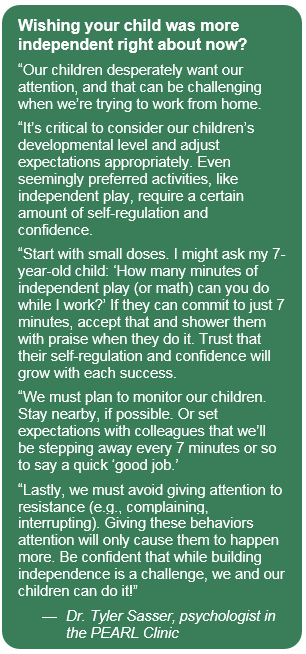
Dr. Tyler Sasser, psychologist and director of behavioral treatment in the PEARL Clinic, an ADHD and behavior specialty clinic with Seattle Children’s Outpatient Psychiatry
There are so many things demanding our attention today — uncertainty about the future, our work, children’s schoolwork, etc. We need to be thoughtful about what we’re giving our attention to. Creating a daily plan with routines fosters predictability and confidence in a time of uncertainty.
I recommend starting with small doses or steps. If you have not been planning, take it one day at a time. If you have been, consider ways to move things forward. Here are some tips:
- Parents and children sit down together with paper-and-pencil to draft a plan.
- Start by brainstorming a list of “want to” activities, or activities that children and/or parents find fun or rewarding. “Want to” activities include time for parents to exercise, parents and children to play together (even for 10 minutes), or children to play a favorite video game.
- Plans will be most successful when “want to” activities are a priority, especially family activities, 1:1 parent-child playtime and physical activity. Resist the temptation to abandon “want to” activities when the day gets full or runs off schedule.
- Consider your child’s developmental level. If you anticipate that a “need to” activity, such as schoolwork, will be challenging, adjust the expectation. Start with small doses or simple steps. And alternate small “need to” activities (e.g., independent play, math) and with “want to” activities (e.g., snack, art).
- Beware of rigidity. Predictability trumps rigidity. Plans will change day to day, and even within a day. Don’t be afraid to “roll with it.” Say to yourself, “We can only do so much. What we don’t get done can be pushed to tomorrow, or not done at all.”
- Beware of perfectionism. It does not have to be a masterpiece — I often write a daily plan on the back of a napkin or scrap of paper.
- Give kids a weekend free from school work if you can. Give them a little bit of free screen time, especially when you can do screen activities as a family, such as Family Movie Night.
We’re all doing our best. Trust that small doses or steps will add up to large and meaningful growth over time.
Take time to build a framework for learning
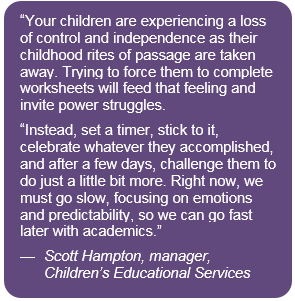
Scott Hampton, manager of Seattle Children’s Educational Services
It’s okay to wait on the traditional academics while your family adjusts to a new routine. We must first address the needs of our children, and ourselves, before advanced learning can occur. By intentionally building a routine now that includes time for wonder and curiosity, you will have a framework for later when you’re ready to add more rigorous academics.
Give yourself some compassion and grace as we all adjust to new roles and new ways of teaching and learning. The expectations for academic learning at home are still being developed. Your partnership with your school will be very important as you both together discover how to meet the emotional and academic needs of your child.
For more recommendations, read On the Pulse’s previous article: Seattle Children’s Teachers Offer Advice During COVID-19 School Closures.
Practice physical distancing, not social distancing
Jim Mancini, speech and language pathologist with Seattle Children’s Autism Center
It’s natural to experience some grief when we’re unable to be near relatives, friends or colleagues. But remember, just because you can’t be physically near others does not mean you can’t be social. There is so much more to being social than physical proximity.
Challenge yourself to engage with others. Get online and play a game with a friend, encourage children to connect with grandparents and other family members regularly using video chat, call or text friends to check in on them and make eye contact, smile and wave to your neighbors during your daily walk (from more than 6 feet away).
Maintaining connections can help us all adjust during this challenging time.
For more recommendations, read On the Pulse’s previous article: How to Support Individuals with Autism during the COVID-19 Pandemic.
Resources:
- Supporting Mental Wellness and Family Life During COVID-19: Comprehensive website to help support families’ mental wellness and assist in adding structure and learning to their day. More resources are being added as they are developed.
- Facebook live panel series Coping During COVID-19: Featuring Scott Hampton, Jim Mancini, Dr. Kendra Read and Dr. Tyler Sasser
- Mindfulness and Biofeedback resources: Extensive resource of stress reduction techniques and guided imagery created by Seattle Children’s Biofeedback team.
- Positive Parenting Videos with Anne Granderson: Positive Parenting Lecture: Managing Big Emotions with Anne Granderson (Recorded Mar. 31, 2020)
- Seattle Children’s Autism blog
- Seattle Children’s School Services resources:
-
- At-Home Learning Tips for Parents (PDF) Expert advice for creating an at-home learning environment to maximize student engagement.
- Braingo! (PDF) Academic-focused Bingo provides fun and engaging activities for students of all ages.
- If…Then (PDF) Dedicated list of action-orientated ideas for students and caregivers to guide them when they are feeling “stuck” while at-home learning.
- Online Resources During School Closures (PDF) Compilation of online education resources vetted by Seattle Children’s teachers to help enrich students’ learning at home.
- Early Education School Schedule (PDF) Sample K-3rd grade school schedule with a comprehensive list of suggested academic activities for early education students.
- Upper Elementary-Middle School Schedule (PDF) Sample 4-8th grade school schedule with a comprehensive list of suggested academic activities for intermediate students.
- High School Schedule and Resources (PDF) Sample 9th-12th grade school schedules with a comprehensive list of suggested academic activities for high school students.
- Anxiety Canada: Challenge Negative Thinking and Helpful Thinking
- Child Mind Institute: How to Change Negative Thinking Patterns

